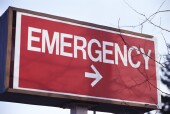New Stroke Prevention Efforts May Be Paying Off

TUESDAY, March 31, 2015 (HealthDay News) — Fewer people are being treated in U.S. emergency rooms for strokes caused by blood clots in the brain, which experts read as a sign that current stroke prevention methods are working.
The rate of emergency department visits for either a stroke or a mini-stroke (transient ischemic attack) — a temporary blockage of blood flow to the brain — decreased dramatically between 2001 and 2011, according to a new U.S. Centers for Disease Control and Prevention report.
Such ER visits declined 35 percent for adults 18 and older, and 51 percent for those 55 to 74, said the report from the CDC’s National Center for Health Statistics (NCHS).
The statistics mirror a “dramatic reduction in stroke fatality in the country, which we believe is likely due to better control of risk factors,” said Dr. Larry Goldstein, chief of the division of stroke and vascular neurology and director of the Duke Stroke Center at Duke University Medical Center in Durham, N.C.
People are preventing strokes by taking cholesterol-lowering statin drugs and medications to control high blood pressure, Goldstein said. In addition, fewer people are smoking, which is a leading risk factor for stroke, and indoor air laws are limiting nonsmokers’ exposure to secondhand smoke.
The CDC report, published in the March NCHS Data Brief, also contained evidence that doctors are providing more comprehensive care for stroke victims, experts said.
For example, doctors more frequently used MRIs or CT scans to evaluate a patient who came to the emergency room with signs of a blood-clot stroke, the CDC report found.
The percentage of ER stroke visits that involved an MRI or CT scan increased 39 percent between 2001 and 2011, researchers said.
Such scans are important prior to giving patients powerful clot-busting medications that can quickly treat a stroke and prevent further brain damage, said lead report author Anjali Talwalkar, a medical officer with the NCHS.
“If it’s a stroke that is a bleed in the brain, you don’t want to give certain types of medication,” such as clot-busting drugs, since they could cause the bleeding to increase, Talwalkar said. “These scans are definitely a critical piece of care for a stroke.”
Experts also found it encouraging that more patients are being admitted into a hospital or transferred to another facility after showing up in an ER for stroke. The number of admissions or transfers increased 10 percent between 2001 and 2011, according to the report.
“That reflects the growing importance of more aggressive stroke treatments,” said Dr. Richard Libman, vice chair of neurology for North Shore-LIJ Health System in Manhasset, N.Y.
These aggressive treatments can include what’s called “drip and ship,” in which patients are given clot-busting drugs at local hospitals and then transferred to stroke centers that can provide more comprehensive care, Libman said.
These stroke centers also have been pioneering ways to clear blood clots by snaking a catheter into a person’s head and removing the clot manually, he added.
Not all the news from the CDC report was positive, however.
The researchers also found that fewer people are arriving at the ER by ambulance after suffering stroke symptoms.
The percentage of ambulance-transported stroke patients younger than 75 decreased 41 percent between 2004 and 2011, the report found.
This decrease happened despite public health campaigns aimed at getting people who may be suffering a stroke to call 911 immediately, Libman said.
“Data and studies have shown that if you have a stroke and you get to the hospital early by ambulance, you have a higher chance of being treated with clot-busting drugs than if you arrive by any other mode of transportation,” he said.
Clot-busting drugs are only effective when given soon after onset of stroke, and doctors may choose not to use them if hours have passed, Libman said.
“Whenever you have symptoms suggestive of stroke, call 911. Get to the nearest emergency department as soon as possible,” he said.
More information
For more on clot-busting drug therapy, visit the U.S. National Library of Medicine.

 April 1, 2015
April 1, 2015




 May 19, 2018
May 19, 2018 




